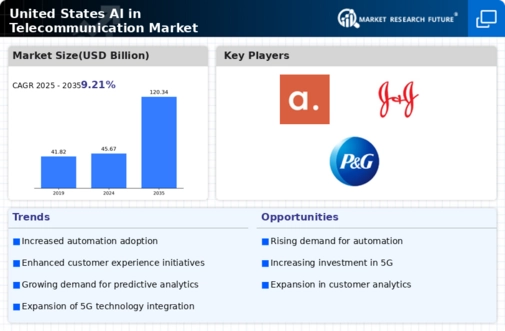Advancements in 5G Technology
The rollout of 5G technology is a significant driver for the ai in-telecommunication market. With its promise of ultra-fast data speeds and low latency, 5G is expected to transform telecommunications infrastructure. AI applications are being integrated into 5G networks to manage the increased complexity and enhance user experiences. The market for AI in 5G is anticipated to grow substantially, with estimates suggesting it could reach $10 billion by 2027. This growth is fueled by the need for intelligent network management and the ability to support a higher density of connected devices, which is essential for the future of smart cities and IoT applications.
Cost Reduction through Automation
Cost efficiency is a critical concern for telecommunications providers, and the ai in-telecommunication market is addressing this through automation. AI technologies are being deployed to automate routine tasks, such as network monitoring and customer service interactions. This shift not only reduces operational costs but also allows human resources to focus on more complex issues. Reports indicate that companies implementing AI-driven automation can achieve cost savings of up to 30%. As the industry continues to embrace automation, the demand for AI solutions is expected to rise, further driving growth in the market.
Increased Demand for Data Analytics
The ai in-telecommunication market is experiencing a surge in demand for data analytics capabilities. Telecommunications companies are increasingly leveraging AI to analyze vast amounts of data generated by users. This trend is driven by the need for actionable insights that can enhance operational efficiency and customer satisfaction. According to recent estimates, the market for AI-driven analytics in telecommunications is projected to reach $5 billion by 2026, reflecting a compound annual growth rate (CAGR) of approximately 25%. This growth is indicative of the industry's shift towards data-driven decision-making, where AI technologies play a pivotal role in optimizing network performance and improving service delivery.
Enhanced Customer Engagement Strategies
In the competitive landscape of telecommunications, customer engagement is vital. The ai in-telecommunication market is facilitating enhanced engagement strategies through personalized communication and targeted marketing. AI algorithms analyze customer behavior and preferences, enabling companies to tailor their offerings effectively. This approach is likely to improve customer retention rates and increase overall satisfaction. Market analysis suggests that companies utilizing AI for customer engagement can see an increase in customer loyalty by up to 20%. As telecommunications providers seek to differentiate themselves, the integration of AI into customer engagement strategies is becoming increasingly prevalent.
Regulatory Compliance and Security Enhancements
As the telecommunications sector evolves, regulatory compliance and security have become paramount. The ai in-telecommunication market is responding to these challenges by implementing AI-driven solutions that enhance security protocols and ensure compliance with regulations. The market for AI in cybersecurity within telecommunications is projected to grow to $3 billion by 2025. This growth is driven by the increasing frequency of cyber threats and the need for robust security measures. AI technologies are being utilized to detect anomalies, predict potential breaches, and automate responses, thereby safeguarding sensitive customer data and maintaining trust in telecommunications services.

















Leave a Comment